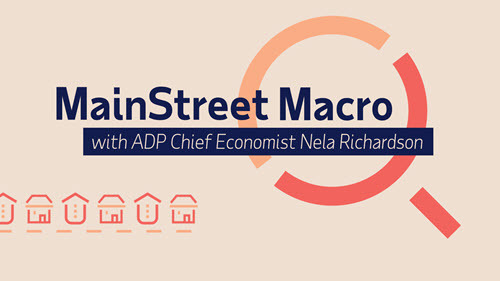The Puzzle of Productivity and Wage Growth During the COVID-19 Recession

"What's driving the disconnect between GDP growth and labor? The answer is productivity. As more workers were laid off, everyone else has become LeBron James at work putting in more hours. This allowed the economy to outpace the labor market recovery." - Nela Richardson, Chief Economist at ADP
The COVID-19 pandemic led to a short but severe recession. Millions of workers lost their jobs and unemployment is still substantially higher than in 2019. Despite these labor market trends, there has also been some surprisingly positive data such as average wage growth and higher labor productivity. But that positivity can be deceiving.
In our second monthly Q&A, Nela Richardson, Chief Economist at ADP, explains what's going on behind this puzzling data as well as what to expect next.
Q: Why did average wages increase during a pandemic and economic downturn?
Richardson: "It's all about the mix of jobs, rather than wages growing for the right reason. We lost 22 million jobs during the pandemic and the folks hit hardest have been low-income. The jobs wiped out were primarily service jobs like retail, hospitality and travel. You can't do these jobs remote, and they are have a higher concentration of low paying jobs.
If you remove people making the lowest salaries from the workforce, guess what? Average wages go up. That's why it's a different impact on average wages today versus the Great Recession, when low-income workers lost their jobs but so did some high earners in fields like finance."
Above: Nela Richardson in MainStreet Macro, Ep. 4
Q: How was the economy able to recover quickly, while the labor market did not?
Richardson: "The economic recovery is underway. The Congressional Budget Office predicts the economy (GDP) will return to 2019 levels by mid-year 2021, and it could be even faster after another possible $1.9 trillion of government economic relief. But their predictions for the labor market are a very different story as they don't anticipate a return to pre-pandemic employment levels until 2024.
So what's driving the disconnect between GDP growth and labor? The answer is productivity. As more workers were laid off, everyone else had to do more. Buffered by technology, we've all become LeBron James at work, putting in more hours while others are sitting on the sidelines. This allowed the economy to outpace the labor market recovery, though we're not LeBron James and that can only last for so long.
Another reason that the recovery has been successful to date is that there's been a lot of fiscal stimulus. The government has sent out trillions to households and businesses to go with incredibly low interest rates, giving them access to low-cost financing across the board."
Q: Are these labor productivity gains a good thing?
Richardson: "It depends on your perspective. A market strategist might look at the situation as a positive. Firms were able to increase revenue with fewer workers, which is great from an efficiency and a profit standpoint.
As a labor economist, I look at that same data and see workers out of the job market. The numbers mask workers feeling real pain, especially those in the lower income segment. It could turn into a drag on the entire economy due to reduced consumer demand, as unemployed people spend less. Speeding up the labor market recovery needs to be part of the public discourse.
At the same time, those productivity gains are likely unsustainable. Workers can only push themselves so hard for so long. The last read of productivity showed a 4% plunge, a sign that the gains can only be temporary and are more an output of the strange conditions we're in."
Q: How will we know wages and employment are moving in the right direction?
Richardson: "The first thing is I'd say is be very careful going forward tracking the direction of your favorite economic indicator. They might not move how you expect. It would actually be a good thing if the average wage growth decreases. We want average wages to go down if that is because more low-income jobs are coming back into the workforce (leisure, hospitality, etc.)
The unemployment rate is also 6.3% today, which isn't bad given that we lost millions of jobs. However, it's artificially low because many people left the workforce due to childcare or for health reasons. Unemployment might go up, and I actually hope it does because that shows people are reentering the workforce because there are more opportunities."
Q: How can the economy create more sustainable productivity gains?
Richardson: "I'm optimistic for the future. As a business community and as a nation, we have this unique once in a lifetime opportunity to rethink the place of work. We know now that not everyone needs to be in the office to be productive. We know the gaps in skills. Now is the time to make those investments based on what we learned over the past year.
As we have this conversation on the economy, we need to ask ourselves, do we just want to bring back all those low wage jobs that are vulnerable to economic shocks be it from a pandemic or something else? Or do we want to create a situation where we have higher paying jobs with good benefits that can adapt to the new economy Post-COVID-19?
Investments in education, infrastructure, clean energy, rural broadband and worker retraining are all ways we can increase the capacity of the American worker, which will lead to an expansion of American growth. Nothing in the pandemic recovery is on script. Good policy could help wage growth in a positive way."
If you'd like to learn more about wage trends and other parts of the labor market, please visit Richardson's 'Main Street Macro' blog. You can also read last month's conversation with Richardson, The Post-Pandemic Labor Market — What Changes Are In Store?
Nela Richardson joined ADP as Chief Economist in November of 2020. Nela is the co-head of the ADP Research Institute and leads economic research for ADP. Previously she was Principal and Investment Strategist at Edward Jones, a financial services firm. In that role, Nela analyzed and interpreted economic trends and financial market conditions and recommended investment strategies. Nela is also the former chief economist at Redfin Corp., a national real estate brokerage and technology company, where she led a team of data scientists, economists and writers to track trends in the housing market. Nela also served as a senior economist for Bloomberg, L.P., covering housing and financial markets, and has held research positions at the Commodity Futures Trading Commission (CFTC), Harvard University's Joint Center for Housing Studies and Freddie Mac. She also worked as an adjunct finance professor at the Carey School of Business at John Hopkins University.
Nela earned a doctorate in economics from the University of Maryland-College Park with concentrations in financial economics, international finance and economic development. She obtained a master's degree in economics from the University of Pennsylvania and a bachelor's degree from Indiana University in Bloomington, where she was a triple major in mathematics, economics and philosophy.





